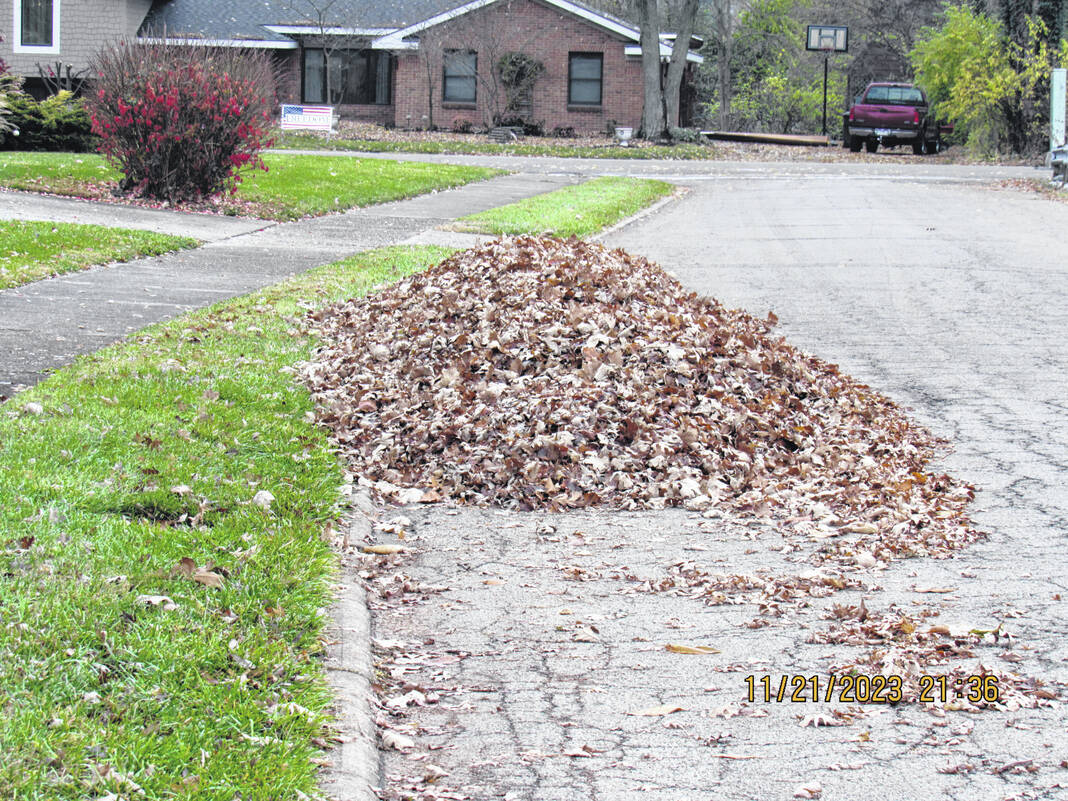
Submitted photo | Jerry Mahan
Leaves like these shown can help your lawn during the winter.
Those piles of leaves seen along the curb in many communities are truly piles of “gold” in terms of what the decaying leaves have to offer our lawns as they break down and decay.
According to Mike Hogan who is an OSU Extension educator in Franklin County, Ohio leaves contain about 50 percent carbon, 1.5 percent calcium and less than 1 percent phosphorus, magnesium, and potassium. Hogan recently wrote an article for the Nov. 3 Columbus Dispatch titled “fall leaves can be used as mulch,” where he made the case for mulching leaves rather than removing them from your lawn. Granted, if you live in a heavily wooded area there may be too many leaves to mulch with your mower and you may want to pile them in an area to let them decay over the winter and use as mulch later.
Generally, once the leaves are 3 to 4 inches deep, they are hard to mulch with a mower. It is best to do this when the leaves are dry so the leaves will be broken into smaller pieces which will decay quicker. Your last mowing should leave the grass about 3 inches in height to help minimize disease problems over the winter. The biggest advantage to mulching leaves is the addition of organic matter to the soil which will help the soil hold moisture and nutrients. So, the leaves are “gold” in the sense they can help improve your soil. The addition of leaves to your lawn or garden soil will not change your organic matter overnight but will help over a few years.
Do not forget to apply your fall fertilizer to the lawn before the ground freezes. This is the most important application of fertilizer in a year and can help build the grass root system. However, I need to add there are concerns being expressed by OSU Extension lawn care professionals on this application related to environmental problems. Concern is related to the low temperatures and inability of a slow or non-growing grass plant to absorb the fertilizer nutrients applied thus laying the possibility of the nutrients moving offsite from rain or snow. This practice of a late fall application of fertilizer is being evaluated by The Ohio State University Turfgrass Department.
Farm Forum welcomes Joe Mullins
Greene County Farm Forum ends 2023 with an enjoyable program by Joe Mullins, who is the owner/manager of Real Roots Radio which includes the station network of WBZI, WKFI and WEDI. With a 40-year history as a broadcaster and professional musician, Mullins has a few stories to tell. “My bumper sticker has been Stressed but Blessed for many years,” he said.
The Farm Forum meeting will take place in the Carriage House Museum, which is part of the Greene County Historical Society, 74 W. Church Street in Xenia, starting at 6 p.m. on Tuesday, Dec. 12.
The cost of the meal is $25 per person. The Greene County Community Foundation (Greene Giving) is again handling the money for the event so make your checks out to” Greene Giving.” Reservations must be guaranteed and are to be sent to Ann Byrd at 1566 Beaverbrook Drive, Beavercreek, Ohio 45432 for arrival on or before Dec. 6. For more information, call Byrd at 937-429-1805. The meeting is sponsored by Greene County Farm Forum and is open to the public.
USDA updates the Plant Hardiness Zone Map
According to a news release, the U.S. Department of Agriculture (USDA) has released a new version of its Plant Hardiness Zone Map (PHZM), updating this valuable tool for gardeners and researchers for the first time since 2012. USDA’s Plant Hardiness Zone Map is the standard by which gardeners and growers can determine which plants are most likely to thrive at a location. The new map — jointly developed by USDA’s Agricultural Research Service (ARS) and Oregon State University’s PRISM Climate Group — is more accurate and contains greater detail than previous versions. The 2023 map is based on 30-year averages of the lowest annual winter temperatures at specific locations, is divided into 10-degree Fahrenheit zones and further divided into five-degree Fahrenheit half-zones.
Plant hardiness zone designations represent what’s known as the “average annual extreme minimum temperature” at a given location during a particular time period (30 years, in this instance). Put another way, the designations do not reflect the coldest it has ever been or ever will be at a specific location but simply the average lowest winter temperature for the location over a specified time. Low temperature during the winter is a crucial factor in the survival of plants at specific locations.
Temperature updates to plant hardiness zones are not necessarily reflective of global climate change because of the highly variable nature of the extreme minimum temperature of the year, as well as the use of increasingly sophisticated mapping methods and the inclusion of data from more weather stations.
Most of Greene County is in zone 6b (we were in 6a) which will have low temperatures of -5 to zero degrees. A small slice of northern Greene County from east of Fairborn to the Jamestown area is in 6a, which has low temperatures of -10 to -5 degrees.
Information on the updated map can be found at https://planthardiness.ars.usda.gov/.
Jerry Mahan is a retired OSU Extension educator for agriculture and natural resources for Greene County. He can be reached at [email protected].

